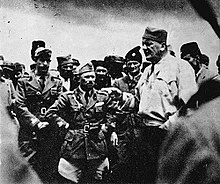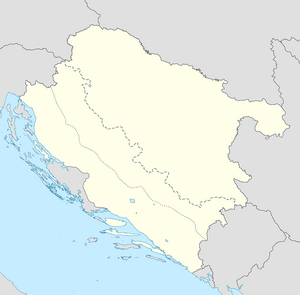Operation Alfa
| Operation Alfa | |
|---|---|
| Part of Prozor, Independent State of Croatia (present-day Bosnia and Herzegovina ) | |
| Result | Partisan retreat and massacre of inhabitants by Chetnik forces |
Operation Alfa (
The operation was arranged between
Background
On 6 April 1941, the
In September 1942, the Chetniks, knowing that they could not defeat the Partisans alone, attempted to persuade the Italians into carrying out a significant operation within their occupation zone. On 10 and 21 September, Chetnik
Timeline
Prelude
In early October, the operation was launched by the Italians targeting Partisans located northwest of the middle part of the
The operation was coordinated with Germans and NDH armed forces located near northern Partisan territory in the direction of
Operation
On 4–5 October the Chetniks crossed the Neretva River in
On 7–8 October the Italians heavily bombed Prozor with artillery and airplanes and entered the town on 8 October.[14] On the same day, Mihailović informed his commanders in Herzegovina that "now is the definite time to wipe out the communists" and to be as tactical as possible with the Muslims and Croats. The nature of these tactics required the Muslims to "only be organized under the command of our [Chetnik] military leaders and in our struggle against the Ustaše and the communists with complete loyalty to the Serb population to repair the shameful role they've played since the capitulation of Yugoslavia up to today". He also called for the Muslims to "take part in the liquidation of those Muslims who still today work against the Serb people". As for the Croats: "what will become of the borders of the Croatian unit and what rights the Croats will have in the new state of the future will depend solely on them". He explained that "if they continue to be inactive, there will be no force that will be able to protect them from the retribution of the Serb people, so let them guide themselves in accordance with that" and announced that after the "liquidation of communists, they will be able to liquidate the Ustaša".[16]
On 14–15 October, the Chetniks, acting on their own, massacred over five hundred Croats and Muslims and burnt numerous villages in the process of the operation on the suspicion that they "harbored and aided the Partisans".[17][18] According to the historian Jozo Tomasevich, incomplete data shows 543 civilians were massacred.[18] At least 656 victims are known by name while another source says about 848 people, mainly "children, women, and the elderly", were killed. Historian Ivo Goldstein estimates 1,500 were massacred in total and attributes the discrepancy "due to the fact that the estimates refer to different territories".[19] The historians Antun Miletić and Vladimir Dedijer place the figure killed at 2,500.[20]

In the following days, around 2,000 Chetniks were in the district of Prozor.[19] According to Hoare, the Ustase complained about the burning of Croat and Muslim villages, and the associated killings of civilians, and this compelled the Italians to discipline the Chetniks and disband some of their units.[21] According to Partisan sources, the Chetniks moved southeast to the Neretva River and Mostar at the request of Italian officers. These sources claim that this was done because Chetnik and Italian atrocities caused great resentment in the local population, especially within the Croatian Home Guard, which felt obliged to intervene militarily in such instances. Chetnik commanders argued that this move was initiated by the Germans to prevent the Chetniks from heading west towards Mount Dinara. After the killings, the Muslim Chetnik leader Ismet Popovac arrived in the town to console the local population and to advise the Chetniks there against committing further atrocities.[19] He also attempted to convince local Muslims to join the Chetnik ranks but was unsuccessful due to the extent of Chetnik atrocities against the Muslim population.[22]
On 23 October, Baćović reported to Mihailović that "in the operation of Prozor we slaughtered more than 2,000 Croats and Muslims. Our soldiers returned enthusiastic." Borba, a Partisan newspaper, also reported that about 2,000 were "killed by the Chetniks in Croatian and Muslim villages of Prozor, Konjic, and Vakuf". The report also mentions that "the districts of Prozor and Konjic have hundreds of slaughtered and murdered women and children as well as burnt houses".[23]
Aftermath
Roatta objected to the mass slaughters and said Italian support for the Chetniks would come to a halt if they did not cease.
After the war an indictment was issued against Jevđević in Sarajevo. It charged that under his command in "the first half of October 1942 in and around Prozor they [Italians and Chetniks] butchered and killed 1,716 persons of both sexes, Croatian and Muslim nations, and plundered and burnt about 500 households". A month after the massacre, Jevđević and Baćović wrote a self-critical report on Prozor to Mihailović in order to distance themselves from responsibility. Jevđević fled to Italy at the end of the war where Allied military authorities arrested and detained him at a camp. They ignored Yugoslavia's request for extradition and set him free. He avoided trial and died in Rome in 1962. Baćović was killed by the Ustaše in 1945.[19]
Mihailović was captured and indicted following the end of the war and in 1946 the Supreme Court of Yugoslavia judged him guilty of leading a movement "which committed numerous war crimes against people" that, among other things, in "October 1942, under the leadership of Petar Baćović together with the Italians, killed in the vicinity of Prozor about 2,500 Muslims and Croats, among whom were women, children, and the elderly, and burnt a large number of villages". He was sentenced to death and executed.[19]
Notes
- ^ Ramet 2006, p. 111.
- ^ Tomasevich 2001, pp. 233–236.
- ^ Hoare 2006, pp. 20–24.
- ^ Hoare 2006, pp. 196–201.
- ^ Ramet 2006, p. 145.
- ^ Goldstein 19 October 2012.
- ^ a b c d Tomasevich 1975, p. 233.
- ^ Loi 1978, pp. 189, 190 & 212.
- ^ a b Ramet 2006, p. 146.
- ^ a b c Tito 1982, p. 322.
- ^ Dizdar & Sobolevski 1999, pp. 346–347, 351–352, 366–367, 371.
- ^ Dizdar 2002, p. 232.
- ^ Dedijer & Miletić 1990, p. 196-198.
- ^ a b Dizdar & Sobolevski 1999, p. 363.
- ^ Goldstein 29 October 2012.
- ^ Dizdar & Sobolevski 1999, pp. 336–337, 339.
- ^ Tomasevich 1975, p. 259.
- ^ a b Tomasevich 2001, p. 259.
- ^ a b c d e Goldstein 7 November 2012.
- ^ Dedijer & Miletić 1990, p. 581.
- ^ a b Hoare 2014, p. 47.
- ^ Dizdar & Sobolevski 1999, p. 365.
- ^ Dizdar & Sobolevski 1999, p. 198.
- ^ Cohen 1996, p. 99.
References
Books
- ISBN 978-0-89096-760-7.
- ISBN 978-86-01-01525-8.
- Dizdar, Zdravko; Sobolevski, Mihael (1999). Prešućivani četnički zločini u Hrvatskoj i u Bosni i Hercegovini 1941–1945 [Suppressed Chetnik Crimes in Bosnia and Herzegovina 1941–1945] (in Serbo-Croatian). Zagreb, Croatia: Hrvatski institut za povijest [Croatian Institute of History]. ISBN 978-953-6491-28-5.
- Dizdar, Zdravko (2002). Četnički zločini u Bosni i Hercegovini, 1941–1945 [Chetnik Crimes in Bosnia and Herzegovina, 1941–1945] (in Serbo-Croatian). Zagreb, Croatia: Hrvatski institut za povijest [Croatian Institute of History]. ISBN 978-953-6491-86-5.
- ISBN 978-0-19-726380-8.
- Hoare, Marko Attila (2014). The Bosnian Muslims in the Second World War. New York: Oxford University Press. ISBN 978-0-19936-531-9.
- Loi, Salvatore (1978). Le operazioni delle unità italiane in Jugoslavia (1941–1943): narrazione, documenti [The Operations of Italian Units in Yugoslavia (1941–1943): narrative, documents] (in Italian). Rome, Italy: Tipografia regionale. OCLC 9194926.
- ISBN 978-0-253-34656-8.
- OCLC 157031947.
- ISBN 978-0-8047-0857-9.
- Tomasevich, Jozo (2001). War and Revolution in Yugoslavia, 1941–1945: Occupation and Collaboration. Vol. 2. Stanford, California: Stanford University Press. ISBN 978-0-8047-3615-2.
Websites
- Goldstein, Ivo (19 October 2012). "Četnički zločin u Rami u listopadu 1942. godine (I dio)" [Chetnik Crimes in Rama in October 1942 (Part I)] (in Serbo-Croatian). Prometej. Archived from the original on 8 January 2013.
- Goldstein, Ivo (29 October 2012). "Četnički zločin u Rami u listopadu 1942. godine (II dio)" [Chetnik Crimes in Rama in October 1942 (Part II)] (in Serbo-Croatian). Prometej. Archived from the original on 8 January 2013. Retrieved 17 December 2012.
- Goldstein, Ivo (7 November 2012). "Četnički zločin u Rami u listopadu 1942. godine (III dio)" [Chetnik Crimes in Rama in October 1942 (Part III)] (in Serbo-Croatian). Prometej. Archived from the original on 22 November 2012.

